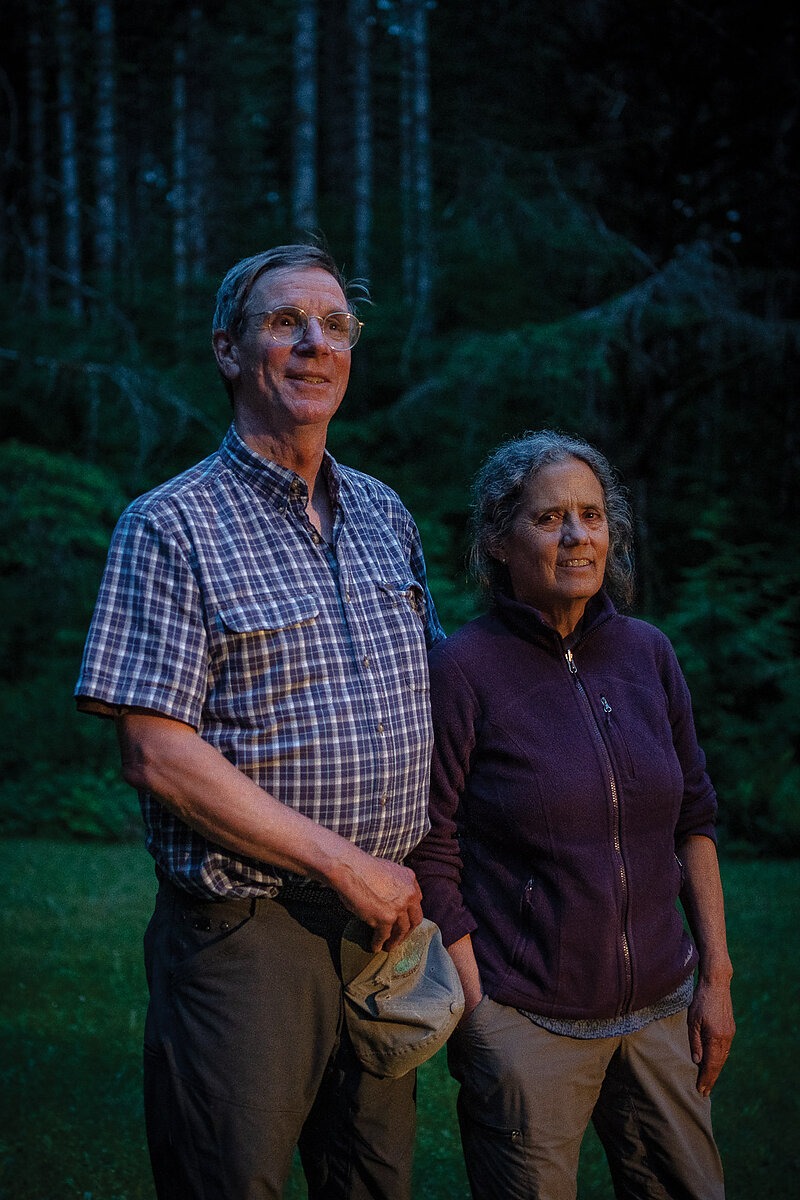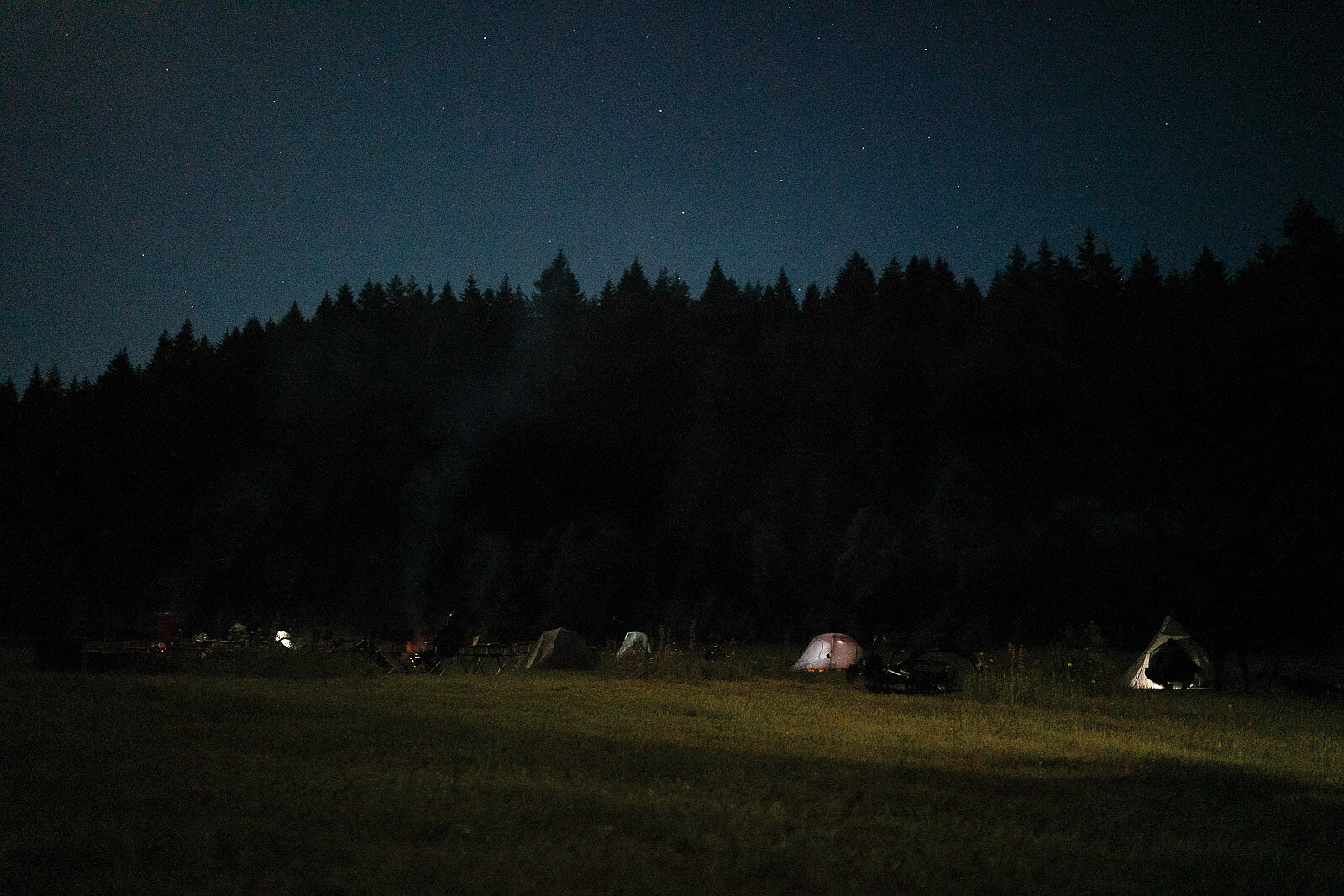
Middle Paths How Hyla Woods and Swift Industries Are Changing the Way We Think About Forests
Words and Photos by Ian Terry
The cascading calls of Swainson’s thrushes and other birds are all that pierce an otherwise quiet forest when Peter and Pam Hayes walk the pathways of their property in the foothills of the Oregon Coast Range on any given summer evening.
Late on a Saturday in June, the voices of 20 cyclists blend with the usual chorus of birds as the riders sit in a semicircle near the bubbling murmur of Lousignont Creek, sipping beer in a sweaty daze after pedaling 45 miles from Portland. The group has come to camp out and learn about the Hayes’ model of progressive forestry.
Peter’s family ties to forestry go back five generations, beginning 20 years before the Civil War when his great-great-grandfather, Orrin, first worked lumber in the Adirondacks before eventually settling among the white pines of the Upper Mississippi Valley in Eau Claire, Wisconsin. Peter’s parents, Ned and Sis, purchased the family’s current forest that now totals some 1,000 acres, spread across three properties in northwest Oregon, collectively known as Hyla Woods.
“We’re an experiment,” Peter says, glancing up at the surrounding Douglas fir trees as he addresses the group. Peter and Pam are carving out a middle path in a region where private landowners have historically fit into one of two opposing mentalities; either plant a monocrop of trees and reap the financial gains of logging or forego profit altogether and focus on conservation by allowing the forest to grow undisturbed.
Their experiment, which began in earnest in the early aughts, includes selectively harvesting small stands of trees, milling and drying the lumber and then collaborating with architects, builders and furniture makers to create a finished product. Smaller-scale items are also available, such as oak cutting boards— their “trojan horse,” as Peter puts it, invading kitchens and reminding home chefs about sustainable forestry with each sliced onion.


Some overarching goals of Hyla are aimed at changing culture and longstanding lumber practices such as improving silviculture, reducing dependence on fossil fuels (its lumber is dried by a solar kiln), nurturing partnerships with likeminded individuals and organizations (Pam and Peter serve on the board of the Build Local Alliance), and expanding markets to add value to forestry for something other than raw lumber (tiny homes for affordable living and recreation are in development). With each venture, the Hayes’ take different routes to answer the same pressing question.
“How do we shift from a culture that too often has been extractive of the land and exploitive of people to become a culture that is regenerative?” Peter says. A niggling truth often surfaces in his work. “Basically, we need a new kind of person.”
Listening in among those gathered to hear Peter speak are Martina Brimmer and Jason Goodman who own the Seattle-based custom bicycle bag manufacturing company Swift Industries. Since founding Swift in 2008, Martina and Jason have broadened the scope of their business from focusing primarily on handcrafting bicycle bags to now offering complete guided bike experiences through their adjacent company, Swift Adventure Co. Whether they’re taking a group to visit Hyla Woods to learn about forward-thinking forestry or leading an adventure art field course, the mission is to foster an environment in which their clients can slow down, look up and pay attention to their surroundings— critical first steps in becoming the “new kind of person” Peter sees as vital to the future of our species’ survival.
“Bringing in more awareness and presence to the ways that we travel is really important,” Martina says, who first visited Hyla Woods eight years ago to teach high school students about native plant ecology and maintain trails on the property. “I’m still really driven to get people to experience travel this way [bike touring]—it’s wildly empowering and brings us so close to the environments we’re passing through.”

The Hayes family views recreation as an opportunity for people to reconnect with forests while also diversifying potential revenue streams for landowners in rural areas. Peter points out that we shouldn’t be surprised by clear-cutting and other harsh forms of resource extraction so long as they continue to be rewarded by hefty profits. Part of the problem is the system itself in which these practices flourish. Increased investment in recreation infrastructure, such as singletrack, gravel or paved trails, provides landowners with an alternative model to making money by, say, choosing to offer accommodations, goods or other services that cater to visitors. The Salmonberry Trail, a proposed 86-mile mixed-use path in northwest Oregon, stands as a potential example of real progress, linking isolated communities through a shared nonmotorized recreational attraction. Once complete, the trail will follow the Salmonberry River and connect Oregon’s rugged coastline with timber towns farther inland.
Long-term success for projects like the Salmonberry Trail will mean attracting more than just hardcore adventure seekers already familiar with pedaling into the unknown. To move the needle, all recreationalists must feel comfortable. Here, Jason and Martina are serving a broader set of cyclists by offering a relaxed pace on their guided rides, a fleet of Kona rental bikes, loaner Swift bags, and even self-guided routes and tours for those who prefer to explore at their own leisure. Getting city dwellers out of their apartments and into the forest where they can learn through direct exposure to their surroundings is ingrained in the company’s DNA—Jason and Martina bonded over their shared love for experiential learning while attending Prescott College in Arizona. The couple continues to refine Swift Adventure Co.’s curriculum to allow memorable experiences and relationships to bubble to the top of a client’s list of takeaways from their trip.
“A lot of the customers and people we spend time with have multiple interests, so why not use the bicycle as a vehicle to explore other things?” Jason says. He’s working hard to expand the field offerings for Swift Adventure Co.’s 2022 season, including trips with a focus on teaching participants about local ecology in regions such as the Methow Valley and greater Puget Sound.
Clare Healy and Sarah Bonenfant joined Swift’s guided ride to Hyla Woods as a way of reconnecting with Portland and its surrounding nature. Feeling cooped up, the couple embarked on a six-month road trip late last year, driving from Sarah’s hometown of Portland, Maine and making their way through the southern states before returning to Oregon in May. Clare and Sarah are experienced outdoorswomen, having hiked, trail run and mountain biked the forests near Hyla Woods before, though they’d never heard of the Hayes family’s commitment to sustainable forestry until their trip with Swift.

The sun hung low in the sky as Clare and Sarah unfurled their tent alongside other campers in a large open meadow. Before long, self-contained campfires crackled and dinners sizzled as riders replenished much-needed calories with meals they'd carried through the day in their bike bags. Late in the evening, when the sky had finally blackened, one guest taught others how to find Polaris, the North Star, by using two pointing stars of the Big Dipper. Frogs croaked in the distance, providing the only ambient noise in an otherwise silent forest. Coyotes howled early in the morning before sunrise while the cyclists slept. The following day would bring scorching temperatures during the ride back to Portland.
Back in the city, Clare reflected on her trip to the private forestry. “I think we left with a larger curiosity,” she said, “and now I’m wanting to follow and take notice to that a little bit more.” The trip sparked further bike-touring plans for her and Sarah. During the summer, they hope to explore Washington’s Olympic Peninsula.
Pam and Peter ask their visitors to think about their relationship to wood and timber much in the same way they do food, that is, being conscious and aware of where it comes from. For those wanting to learn more, they recommend sources such as David Low’s Good Wood Guide (physical copies can be hard to find, though similar online resources are available) or the Forest Stewards Guild, a national organization whose mission is to nurture responsible forestry.
“We need to reimagine our relationships with forests and then act on that and create relationships that don’t degrade the forests,” Peter says. “You’re not going to do that in a society that’s becoming increasingly urbanized without getting out and doing things in the woods.”
As interest in outdoor recreation booms, Peter hopes those enjoying time outside will seek moments on their rides or runs to look around and notice what the forest has to offer or, better still, take note of what they can offer the forest. Exercise for the heart, but also for the mind. A cultural shift is necessary, one in which individual values overlap with what’s good for our woodlands. Hyla Woods and Swift Industries are both playing a role, each in their own way.